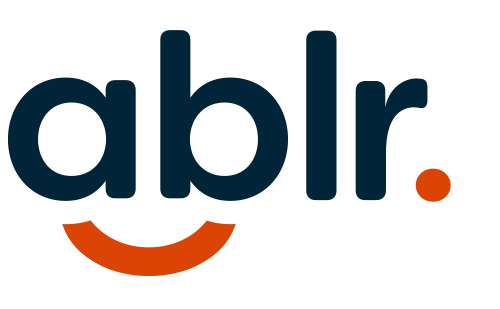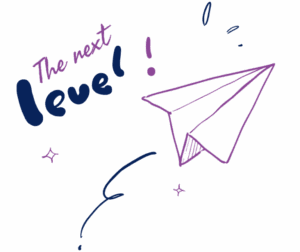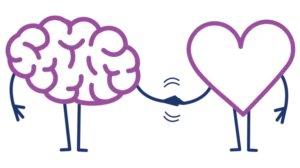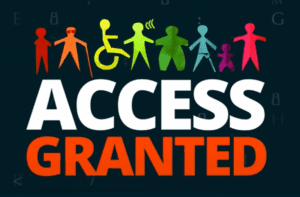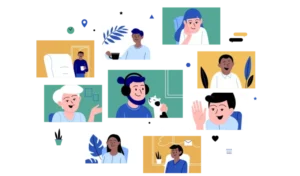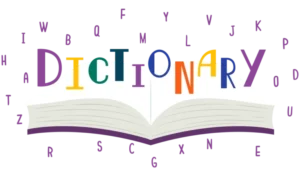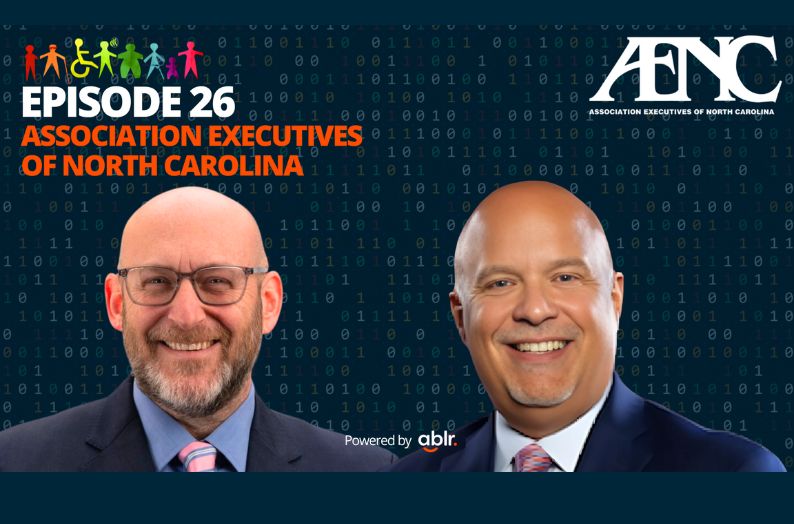Access Granted: Association Executives of North Carolina Transcript. Tune in wherever you listen to podcasts.
Mike: Welcome to Access Granted the podcast where we uncover stories of innovation, inclusivity, and the organizations leading the way. I’m your host, Mike Iannelli, and today we’re turning the spotlight on AENC, the Association Executives of North Carolina, a powerful connector and catalyst within the association community.
Joining us is AENC CEO and passionate leader committed to shaping the future of professional associations and championing accessibility is a key part of that vision.
This is a conversation you won’t want to miss about bold leadership, community impact, and the steps it takes to build associations that truly serve everyone.
Alright Rich, I appreciate you being here my friend.
Welcome to Access Granted, the Ablr podcast where we talk a lot about accessibility, we talk a lot about disability advocacy. The whole purpose of this engagement is always about bringing on individuals and organizations that are really focused on life-changing activities that are inclusive of all people. And your position at AENC and our relationship historically, you’ve come to a lot of our events, you’ve always been a big, big believer of what we’re doing in our mission, and I wanted to bring you on today just to kind of share some of your background, talk a little bit about some of the things that you’ve been doing there at AENC and then some of the work that we’ve done together.
‘Cause oftentimes, Rich, you know, it takes a lot of courage to kind of step out of the gates and be uniquely different. Especially in a world today, right? But the one thing that always stands true is that, and from my perspective and from others in our industry, it’s accessibility is not an option. All people should have that access and inclusion.
So I wanted to start it off. Gimme a little bit about yourself Rich. What, how you got into AENC and talk to me a little bit about what you’re doing there.
Rich: Yeah. Well, Mike, I appreciate you having me on the podcast today. Huge fan of yours and John’s and the entire team at Ablr. So thank you for having me on.
So I’ve been with AENC now, this fall will be nine years before coming to work at AENC as a CEO. I was a member of AENC for several years and, you know, just fell in love with the organization for a lot of reasons. And back in the fall of 16 I was approached to come serve as their next CEO. I love the organization.
I love what they were doing. I also had to believe at that time that, you know, our brightest age show ahead of us at AENC. So took that leap from being a member over to being a staff person. And it has been just it’s been a privilege of my lifetime being to serve this membership.
Mike: Yeah. So you were a member for a while.
What kind of like drove you, I mean, obviously being approached into this opportunity sounds exciting, but the Association of Associations right. So at Ablr we work with a lot of different associations and associations have the ability to impact a lot of people right. So from your perspective, being a member side and all of a sudden now you’re leading that, talk to me a little bit about what was that driver for you to get in the association space and just gimme a little bit of, a little bit of insight there.
It would be helpful.
Rich: Yeah. So you as a member of AENC. We became very familiar with the mission and the vision of what they were trying to accomplish. You know, at the heart of most associations, certainly the heart of AENC, it’s all about service. It’s all about giving back. It’s all about connecting people, making sure they have the education, the resources they need to be successful in their jobs.
So when the opportunity became available to work centrally in an organization that has such, as you mentioned, great impact across the state of North Carolina, and be able to serve not only our members. Hopefully through the good work we do together, be able to serve their members. It was a pretty inspiring opportunity.
You know, as you mentioned Mike, associations are in a lot of ways a hub for or professional trades and businesses in North Carolina around the country. And you know, AENC, we’re three person staff. We’re not a very big organization, but one arm length from our members represents the majority of people that work in the state of North Carolina.
So I think the girth and the reach that the agency has, it’s more than just. To our members, although that’s awesome. Hopefully for the good work we’re together we can inspire and create some change across the entire state.
Mike: Yeah. And so talk to me, I mean obviously you’ve been there for a bit.
North Carolina is exploding right now. Right? So have you seen a tremendous amount of membership growth over the last few years?
Rich: We have. So in 2016 when I took the helm, we had about 550 members. Today we’re bump right up to about 950 members. So we’ve grown. We’ve actually even saw growth during COVID, so that was a whole different time.
But, you know, the membership at a NC is incredibly loyal. It’s a big family network. So we stuck together through the tough times. And I would say, although the growth has been pretty good, we’ve grown responsibly. We wanna grow better, not just bigger, but just we wanna grow better and be the organizations that wanna grow and thrive.
And without question, North Carolina right now, it’s just a great place to live, to raise a family, to bring your business to work. As a result, as North Carolina’s grown, so is the association industry, and that’s a great thing, right? So a lot of our growth has come because of our members growing. So when a member brings out new employees, they will reach them out to us.
They will connect with them and bring them on board. 70 years ago when we began AENC was largely a focus to help CEOs of associations. We’ve grown to coin an hour today. We help could be a first year marketing assistant all the way up to the CEO of an organization. Several associations have 20 plus of their staff members are our members.
We really take the entire lifecycle of the employee in the association world and provide education, connection, training from the very beginning stages all the way through the seasoned people. So because we’ve grown our reach inside of associations. We’ve added more associations to the membership roster over the years.
It’s been a very humbling and fun ride to see the growth.
Mike: Yeah. So talk about some of the services that you provide for these organizations and how do you sort of help an organization sort of get started and then obviously from a long-term perspective, what is sort of the, the value that they get from this relationship with y’all?
Rich: Yeah, no, great question. So the membership is made up of really two different groups of people. So we have our association members. That makes up those are anyone employed by an association that makes up about 60% of our membership. The other 40% are we call affiliate members. So there’s affiliates and CBBs, convention visitors, bureaus.
Those are all organizations that provide services to the association industry. Many hotels that are members, CPA firms, law firms, groups like Ablr, or anyone that provides goods and services to the industry can also be a member through the affiliate route. So those are really the kind of two memberships that we offer up.
But I would say the commonality, if you’re an agency member, first and foremost, I hope the experience of our member is that they just don’t feel like a member. We want very quickly for people to feel like they’re part of our family. As a staff, we’re gonna do anything in our power to make sure they are successful in their jobs, in their lives.
Today, our mission is to help our members succeed, and every decision we make goes through that prism. Is it gonna help our members succeed and for an association member help ’em succeed? Maybe through, provide an education on one of our conferences to help them run their association better. It may be through something like a public speaking class that’ll help them be able to interact with staff more or board members more.
Mike: Now, is that stuff virtual or is that, do you guys do a lot of that in person? Like how does that work? Do you travel on site and do a lot of these things, or a lot of is virtual?
Rich: Both, but the majority is now on site. Even when we’re on site, we’ve got several major educational events throughout the year.
Even when we’re on site, we always offer a virtual component. With the concept of being, even though only a handful will take us up on that today, we wanna be people where they’re at. At the end of the day AENC is all about connecting people to each other and the goods and services they need to run the business.
Mike: Yeah. Do you find that there’s a network of these folks that actually communicate as a community outside of the relationship with the AENC? So they start to, once they come in, they meet each other, then they start having their own sort of external sort of task force or group meetings or networking events, how does that kind of work?
Rich: I would say on an informal level, absolutely. Many of us, I’ve been around AENC now for probably 16 years as a member as a staff person. Some of my deepest and longest enduring friendships are through AENC I think many members that have been around AENC for a while, which say the same thing.
So there are very deep connections and bonds made. So the ability to form relationships, to create friendships is great. This is also agency is a mechanism where you can form those relationships that go outside the borders of agency. So you have a trusted friend in the business.
Mike: So talk to me about why you think associations are so important and in the professional ecosystem.
Rich: The primary purpose, whether it’s nationally, internationally or state level of an association, is to bring colleagues together, your professional or trade association colleagues together.
To first, again, is to learn from each other, just to kind of bring people together. We have a similar interest, similar passions, similar jobs to learn, but from a broader perspective. You know, if you’re a member of the North Carolina Medical Society or the Bar Association, you are engaged in lobbying activities for the betterment of your membership.
So trade associations, professional organizations they work hard to educate their members, help them run their businesses better, but also make sure they’re advocating for it against legislation that’ll help them be successful in their careers.
Mike: So how do, it sounds you’ve got almost 900 members.
You’ve got. Yeah that’s a large amount. You’re doing events, you’re doing obviously virtual events. You’re providing a lot. How do you do that with three people?
Rich: Two really, really awesome staff people. I think Mike, if they say something about me when I’m gone, it’s hopefully that I hired well, and we’ve got great SAP people are very committed.
And we have also worked very hard on really trying to understand who we wanna be as an organization. What are our priorities we wanna focus on. There’s many things we would love to do that we can’t do because at the heart of what we do, we are here to serve our members. We’re here to love our members and a way that helps them be successful.
It’s a lot of work. But you have great people it makes it a lot easier.
Mike: I want you to kind of take me back a little bit. What is your first sort of memory of Ablr?
Rich: It’s actually great, a great memory. So John came to one of our conferences and someone told me he was there. I stepped aside. We had a great conversation and somewhere in the middle of the conversation I had this horrific epiphany on our registration forms.
We asked for things like special dietary needs, but we did not ask on that form, the most basic thing we should be asking. That is, are there accessibility needs that we can assist you with? And I remember the conversation with John. I think I kind of digressed into a little bit of a mud hole. And I said, John I can’t believe that we had done this.
I said, I mean, like, what was I thinking? I can’t believe. And John literally said, Rich. He goes, back off the edge. He said, I bet going forward you guys will be doing that. And I said, as of today, we will never again not ask those questions of our members. If we’re gonna be thoughtfully and intentionally inclusive, we’ve gotta get better.
And I loved it that John was always very complimentary of our organization. And even though he registered through a form that did not ask if he had accessibility challenges that we could assist with, he still showed up and he was a great guy. And in that conversation, it was one more light that sort of came on and said, we think we’re do, we’re doing better.
We think we’re pretty good. But being an intentionally inclusive organization, it’s a daily opportunity. It’s not a struggle. It’s not an initiative. It’s a daily opportunity for us to get better. And John Samuel and your entire team at Ablr, they helped us get better.
Mike: So talk a little bit about the inclusion.
I know we’ve done some work together supporting in some of the accessibility, doing some manual testing on your content.
Rich: Yeah. So rewind the clock back a little bit. Probably seven or eight years ago, we began an initiative around women in leadership. We wanted to celebrate or recognize women that are doing great things.
It was a really nice launch for us into being a more thoughtfully inclusive organization. When Drell Noel is our board president, he kept on saying a word to me that it finally sunk in and he was using the words being intentionally inclusive. And that really resonated with us to a point where it’s very, become very much part of our DNA, so to speak, that we wanna be thoughtful in every way.
It is age, it is race, it is gender. It is also accessibility needs. It’s also battery. It’s everything that we can do to make sure that AENC is a place that. Not everyone just has what they need to function, but that they feel welcome. It, to me it’s just basic human understanding and kindness.
It’s about being kind Mike. It’s about doing the right thing. It’s also makes really good business sense to make sure that you are being as thoughtfully and attention inclusive as you can make.
Mike: Why do you believe it’s such an essential part of the community’s mission? I mean, ’cause if association members and their members can’t access content, it doesn’t do them any good. Right?
Rich: Right. Accessibility to us. And when I first talked to John in that conversation, the reason why it was like this horrific epiphany was I couldn’t believe we hadn’t thought about it. You know, if you’re gonna show up to our events and you can’t see or hear or be able to physically access spaces need to access right outta the gate, it will be impossible for you to have a fulfilling experience.
So it’s a very foundational thing for us. And so whatever the accessibility need is our job. Is to make sure that we are not just providing the basics, but asking people how we can be of a better support. And I’ll go even one step further. About a year ago we did a really cool session, one of our conferences, and it was around what we called hidden disabilities.
We had someone on the stage that had a traumatic brain injury. She talked about the challenges of late day. Someone’s on stage with MS. Those are not things that you can see, and yet the accessibility needs. Someone with MS can be significant. And so what can we do by asking how could we serve you better?
I think we open up opportunities. ’cause historically, Mike, I think what happens is people that didn’t feel like they were included because it wasn’t accessibility opportunities for them to be successful. They just didn’t come. Right? They didn’t show up or they sat in the back and they couldn’t see the screens, they couldn’t hear, they couldn’t access tables or they felt like they were really
Kind of an island by themselves and typically those folks would just not come back.
Mike: The point is if you’re not creating accessible, digital accessible experiences that all people can access, they’re not coming back and they’re sharing that disappointment with others. And that has an impact, especially today’s environment.
Definitely has a business impact. So talk about from a digital perspective, what kind of role do you feel like you play in there as well?
Rich: Well, I think from the first perspective is we’ve got a model. The corporate behaviors that we are encouraging others to follow. You know, while again we were not at all digitally perfect.
We wanna make sure that we had a pathway to keep on getting better, even if that meant that we couldn’t become perfect overnight. And you guys were wonderful at creating a roadmap for us to kind of keep on navigating and moving in the correct direction. So I think part of it’s modeling the behaviors, but I think also part of it is when we’re able to put someone like John on stage.
Our members can experience and learn from people like that in our Hidden Disabilities workshop recently, where you can look and learn and say, you know what? These are my friends, these are my colleagues. It’s not a factor of whether or not there is accessibility to each. It’s what you do with it, right?
And so those needs exist. You can choose to turn a blind eye to it or through education. What we wanna do is just shine a light on this. So when John’s on stage he was funny and smart and articulate, did a great job for our members, but we wanted our members to experience some of the challenges that he experiences when he’s at conferences and events.
So, through the modern behaviors, through putting the right men and women in the right places on keynote stages or breakout sessions or workshops, to be able to walk away with sort of concrete plans and ways we can get better. That’s a big way we see we can make an impact.
Mike: What did you learn from that and was it eyeopening for you as well to know that, hey, this isn’t as simple as an automation, this is really a level of effort and support to make sure that all people have that true inclusive experience?
Rich: Yeah, I think from the very beginning, one thing that Ablr did exceptionally well was they didn’t make us feel bad for where we were. Once we started thinking about how we could become more intentionally inclusive in the space of accessibility, I don’t think our digital stuff was bad. It was not nearly where it needs to be.
But many folks will approach us with the threats and the fears of threats of lawsuits and fines, and they exist, and that’s a reality and a fact of business life. Y’all didn’t come to scare us. You know, we kind of sat down and said we share a like passion for doing better and, you know, AENC we’re a $600,000 a year budget.
We can’t just lift the switch and do everything we want and in any area, but we wanted to get better. And you guys understood that. And you create a roadmap for us. It’s an intentional process to make sure that we got better then, but as we’re adding new content that we’re doing it correctly.
So you guys were just really extraordinary of understanding the challenges, associations, the opportunities, meeting us where we’re at, and then helping us start to take steps that today we continue to do those steps to make ourselves better.
Mike: Yeah. And education, you mentioned education. That’s such a big component because again, a lot of what we do at Ablr is I always say, give a man a fish, teach a man a fish.
Right? We kind of do both, right? We sort of provide a lot of the consultation upfront. We do a lot of the auditing, provide you all the violation insights. Then we don’t go away and it’s part of this online, or I’m sorry, ongoing collaboration. One of the biggest components is sort of after all this work gets done and we’re all aligned and the site is performing well, it’s the ongoing education piece.
It’s teaching and educating content creators and web owners about the importance of creating content so you can maintain that accessibility. Right. So talk a little bit about the education pieces and what you’ve learned through the process. And how are things going with the site today? I’m interested,
Rich: You know if AENC was a staff where we had a tech team of six people.
I think it would’ve been different. We literally cast one person at that time to say, Hey, can you spearhead this up with Ablr? And that was one of the many, many hats that person, we kind of gave her a new hat to wear. But y’all understood that, you know, you could take someone who has 25 other hats. This is one of them.
And you know, how do you speak the language of that person so they can routinely be good at what they’re doing and be in more intentionally inclusive digitally.
Mike: And the other part is we try to make it fun, right? Because again, you said it earlier a lot, there’s a lot of threatening going on today.
Fear-based marketing, fear-based, Hey, if you don’t do this, you’re gonna get sued and spend 20,000 here and $600 an hour here. And it gives accessibility sort of a bad vibe. And at the end of the day, what we’re doing at Ablr is we’re trying to create an environment that is inclusive, but accessible, but usable, but in a way that educates and helps people understand the importance of it.
Not by creating this fear-based, if you don’t, this will happen, but it’s an intentional desire to do better. And so when you start to think about like your industry specifically, right? What are some of the common threads and challenges that you see as it relates to accessibility, especially in today’s landscape?
Rich: Probably the biggest single challenge that most, at least state level associations face is staff bandwidth, right? I mean, we’ve got projects and events we’re working on nonstop, and we’ve got board interactions, board make. There’s always things that we’re working on, and when you put one more task on somebody’s plate.
Either something else doesn’t get done or you start to put that person more underwater. So bandwidth is always a challenge, which is why you guys were so good. Understanding that we don’t have an IT person. We’re never a tech person. We have someone that’s gonna take on this responsibility. So you are wonderful in that area.
The other thing that makes it sort of salient for a lot of associations is because we are in the business of serving our members, this is an area that we wanna get better in, and you guys are very helpful with us in that. Defining this as a priority in the sense that you can’t be, by definition, partially inclusive, right?
I mean inclusivity is a fairly totalitarian word. So if you’re gonna be an inclusive organization, you’ve gotta be thoughtful of everything and push experiences, digital, everything. And so we committed to being an intentionally and thoughtfully inclusive organization. Now you start looking at the elements that’ll help feed that priority, right?
And help create our mission. You guys were part of that. And the more that we can put people like yourself and John on our stages for education, I think most associations understand this isn’t something that they could be doing or should be doing. It’s really a priority should be a priority of associations to be the very best thing to be at it.
Mike: So when you think about like future ready organizations, right? Some new, the newer organizations, large, small, midsize that are coming on. What ways do you see accessibility really contributing to like strengthening those organizations?
Rich: To me, it inclusivity is all encompassing. And if we’re going to truly be an inclusive organization to our very best, to be intentionally inclusive, that by definition has to include accessibility.
And so when John sort of opened up our eyes, we say, okay. This makes sense. If we’re doing well with age and race and gender and dietary needs, great. We gotta keep on doing great in those areas.
Mike: Love the dietary needs, by the way.
Rich: Yeah, I mean it’s a.
Mike: Tell me about recommendations.
Rich: Yeah, it’s an evolving landscape.
You know, people that have special dietary needs at conferences, so that’s an ever evolving opportunity for us to get better. But by definition, if we’re gonna be intentionally inclusive, we’ve gotta say folks that have any level of accessibility challenges, we have to be there. We’ve got to invite them to the party and give ’em a seat at the table and say, you’re loved, you’re with us.
So the future ready organizations, everyone struggles for countless staff, right? We’re all engaged in trying to find finding keep the best staff. I am absolutely convinced that you find and keep the best staff by being the best organization you can be. Bottom line matters. It keeps the lights on. But being an organization that’s mission driven, being an organization that most associations are, that are out there to serve, it fits like a hand in glove.
So at whatever organization, your association, you’re at the future. Ready Groups are the ones that say we are gonna embrace everybody. ’cause keep in mind, one arm length from our associations. Represents hundreds of thousands of people I work at State of North Carolina. So for example, the North Carolina Dental Society was at our conference and saw, you know, John on stage.
If they go back and you know, say you know what, we’ve gotta get more thoughtfully intentional about this area of our inclusivity and our accessibility, and they teach 5,000 dentists in North Carolina that. And several of those folks walk away saying, Hey how could we be better with our patients?
All of a sudden, the impact is phenomenal.
Mike: Part of the thing is it’s action, right? Yep. I mean, we can go to events we can hear things, we can see people talk and say, wow, that was great. It was really inspiring and I’m gonna go back and just do my work. So from an association’s perspective, you know, how do we empower your organizations and all organizations and associations across the country to really kind of take something and roll with it?
How do we activate that, in your opinion, across the association landscape?
Rich: Sure, you know, I had a conversation with Donald Thompson a couple years ago with the diversity movement, and you know, I love the way he phrases it. You know, and, and you talk about doing it for the right reasons, but I love the way that Donald talked about all matters relative to inclusivity.
There’s a business imperative there, and the imperatives can be several things, right? I mean, one is you tracking your hitting key talent. That’s a challenge of yours. This is a space that you need to get better in. Then you say, okay, we’re gonna do our very best to create the environment that our members be successful in, and that drives business results.
That’ll talk about it. We’ve learned it, and I think the ability to get out to more associations because of that demand for time that lack of bandwidth of staff. I would suggest anyone that asks me that, focusing and prioritizing intentional inclusivity, it isn’t a function of something you want to do.
It’s something that you need to do. There’s a very strong business reason why, and if you wanna be future ready you better be there.
Mike: Yeah, that’s a great answer. I mean, one of the things I just keep thinking of is, it’s always been like the checkbox, right? And it’s how do you take organizations from just, Hey, this is just something I’m just gonna check it off to something basic to Z I’m gonna incorporate this in my DNA.
You talked about that earlier. This is in our DNA. There’s a shift happening right now versus something I feel like, again, feel like I have to do. Versus what I want to do or what I should do. Yep. And I think there’s again, we talked about this earlier. We started, there’s a lot of confusion. Do I need to do this?
Should I do this? Does it matter? And I keep going back to this, it does matter. And organizations are saying they’re, they just don’t know if it matters. And so this isn’t a political move or an agenda move. It’s about doing the right thing. What would you say to individuals out there and organizations big and small that says, Hey this is not really optional.
This is something built in to make sure that everybody has the same access for things. I mean, I’m just interested in your opinion there.
Rich: I think there’s sort of a two-pronged answer to that, Mike. I mean for it to become part of your DNA, it’s got to be something that touches you correctly at the heart level and at the eye level, right?
We all know many, many people that experience challenges, so I think to open up people’s. Harsh to say, and you know, you may be perfectly able today, however, maybe your friends, your colleagues, your family are not, I think sort of softening the feels that way in someone’s heart makes sense. It’s real it’s a true case in order to get to the intellectual or the mind part of it, you know, that’s again where Don Thompson talked about the business imperative.
You know, I would look at and say this as example. Most association meetings I’m in, there’s some level of discussion around member engagement, right? Something that we’re all focused on. You have a choice to renew your membership due or not. So how do we keep them engaged? What does that mean? We’re constantly talking about this.
What’s not talked about enough is if you wanna engage your members, you better provide opportunities and vehicles for them to be able to engage, right? So how many AENC members over the years. Have wanted to come to a conference, but they couldn’t see well enough. They stopped coming or they couldn’t hear well enough.
They stopped coming, and they were silent. They just went away. So if you really wanna get into the nuts and bolts of member engagement, I would say that it’s fundamentally important that you’re creating live and digital experiences, that everybody feels included and welcome. If you’re not doing that, all the other stuff doesn’t really matter.
If you’re not creating that culture where people feel like they’re loved, feel like they’re included. All the other cool things we come up with just don’t matter. It’s so foundational. It’s almost like the building blocks of any good member engagement plan has to be. We want you engaged for a variety of reasons, in a variety of ways, but we’re gonna make sure at any every intersection there is a way that you can successfully and physically engage in experience.
So I think when you look at the intersection of these things that we consider like the nuts and bolts of business. Things like accessibility or inclusivity. I think there’s not a bridge between these two things. I think they’re very much interwoven.
Mike: Yeah. I was just gonna ask you, what do you see, how are you leaning into encouraging your associations to do this?
So it sounds like you’ve answered that right there, just confirming that it’s important and everyone should be doing it. So, talk a little bit about how you’re incorporating a lot of these other movements into the future of your strategy with AENC.
Rich: So the development of AENC in the future.
I would look first of all to the past and say that there were many wonderful men and women that have built this organization for 70 years. But there’s a lot of effort that has gone into building who we are today. And as I look to the future, I absolutely believe AENC’s best days are ahead of us because we are very open and always thoughtful of how can we do better.
John helped us do better. When we had this session around hidden disabilities, we got better. And so understanding the mile top may not ever be reachable, but that mile top is what our goal is. It allows us to say, you know what? We’re doing well today. The membership’s doing well, but there’s uncharted territory out ahead of us, and there’s ways that 10 years from now we should be better than we are today.
And Mike, a huge part of that. My belief is that associations have to continue being a strategic business partner for our members. I think gone are the days that you joined an association because you were supposed to. Those days are gone, and now we’ve gotta make sure we’re continuing to create the business value proposition for being a member.
I believe a big part of that in the future is making sure that we are strategic business partners. So if we go back to what Donald Thompson talked about, we go back to accessibility, inclusivity being a strategic fundamental imperative to build all this other stuff on. It’s very much a strategic imperative.
And so our, the platform that AENC has. Mike is just to continue modeling the right behaviors, bring in folks like y’all and other amazing men and women that have shared experiences and lived experiences and can talk about the past. Let’s celebrate. We’ve done well, let’s understand what we did do well, and let’s commit to a path going forward. That’s better.
Mike: Yeah. So what advice would you give some of your association, sort of leaders that, that are trying to get into this for the first time or trying to understand it? What other things would you say to them as they’re walking into this new world? Especially in today’s environment.
Rich: Great question. You know, and a lot of those conversations are couched in fear right now around executive orders. And what we can do and can’t do, and my encouragement to anybody would be, whether it’s state level, local, state or national. Every couple years there’s new elected officials come into office.
So whether or not you, like he or she or whoever is there, now, it’s all gonna continue changing. The landscape will continue evolving. So when it’s part of your DNA. When it’s part of something that is you believe is fundamentally important to how you run your business, how you engage your members, well then you’re less concerned with the other things that happen at a local, state, or federal level with elections, you know, and, and I fully understand, there are associations that have funding sources that could be impacted based on words they’re using or things you’re doing. I get all that. You’ve gotta be able to navigate those times correctly. But back in the words of true pedigree, keep on doing the work.
Mike: Right. Keep on doing the work. Well said my friend. So finally what would you say to someone that doesn’t think accessibility applies to them?
Rich: Hmm. It’s a great question. I’ve had this conversation on several occasions. It’s not a function of whether or not inclusivity accessibility applies to you, your staff, your members, your clients. It does your choice. Is what you do with it. Your choice is how you choose to build a culture around being all things inclusive.
The fact of that, the thought that any membership group or client base or anything is not diverse is simply factually a misunderstanding. We are a very diverse society. That’s a fact. Being inclusive is an act that follows that up. And so if you say, Hey, I don’t have a diverse population, you just don’t understand your populations.
So the facts exist. The question is, what do you wanna do about it? Do you wanna become more accessible or do you not wanna become more accessible? And there’s reasons for both, but it’s not a function of like, eh, it doesn’t really apply. It does apply to all of us. We get to choose how we respond and how much we make that part of our core priorities to drive our businesses.
Wow.
Mike: We’re gonna quote that one my friend. I appreciate your time there, Rich. It’s been joyful and I’ve really enjoyed the discussion. A lot of good insights. We appreciate all your support and so thank you for being here and we’ll do this again sometime soon.
Rich: I appreciate you, Mike, and all the great work Ablr’s doing, so keep it up.
Mike: That’s it for this episode of Access Granted. Thank you for joining us. Today we explored the powerful roles associations play in shaping industries and how AENC is leading by example when it comes to accessibility and inclusion. From rethinking how they communicate and serve their members to embedding accessibility into long-term strategy, AENC is proving that real leadership means creating spaces where everyone can participate fully. Whether you’re part of an association leading one or just curious about what it means to build more inclusive communities, we hope this conversation spark new ideas and inspiration.
